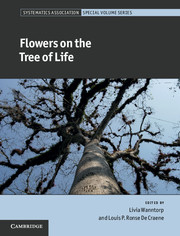Book contents
- Frontmatter
- Contents
- Contributors
- Acknowledgements
- 1 Introduction: Establishing the state of the art – the role of morphology in plant systematics
- 2 Spatial separation and developmental divergence of male and female reproductive units in gymnosperms, and their relevance to the origin of the angiosperm flower
- 3 New flowers of Laurales from the Early Cretaceous (Early to Middle Albian) of eastern North America
- 4 Tracing the early evolutionary diversification of the angiosperm flower
- 5 Changing views of flower evolution and new questions
- 6 Centrifugal stamens in a modern phylogenetic context: was Corner right?
- 7 Evolution of the palm androecium as revealed by character mapping on a supertree
- 8 Comparative floral structure and development of Nitrariaceae (Sapindales) and systematic implications
- 9 Multiplications of floral organs in flowers: a case study in Conostegia (Melastomataceae, Myrtales)
- 10 Ontogenetic and phylogenetic diversification in Marantaceae
- 11 Floral ontogeny of Acacia celastrifolia: an enigmatic mimosoid legume with pronounced polyandry and multiple carpels
- 12 Floral development of Napoleonaea (Lecythidaceae), a deceptively complex flower
- Taxon index
- Subject index
- Plate section
7 - Evolution of the palm androecium as revealed by character mapping on a supertree
Published online by Cambridge University Press: 07 October 2011
- Frontmatter
- Contents
- Contributors
- Acknowledgements
- 1 Introduction: Establishing the state of the art – the role of morphology in plant systematics
- 2 Spatial separation and developmental divergence of male and female reproductive units in gymnosperms, and their relevance to the origin of the angiosperm flower
- 3 New flowers of Laurales from the Early Cretaceous (Early to Middle Albian) of eastern North America
- 4 Tracing the early evolutionary diversification of the angiosperm flower
- 5 Changing views of flower evolution and new questions
- 6 Centrifugal stamens in a modern phylogenetic context: was Corner right?
- 7 Evolution of the palm androecium as revealed by character mapping on a supertree
- 8 Comparative floral structure and development of Nitrariaceae (Sapindales) and systematic implications
- 9 Multiplications of floral organs in flowers: a case study in Conostegia (Melastomataceae, Myrtales)
- 10 Ontogenetic and phylogenetic diversification in Marantaceae
- 11 Floral ontogeny of Acacia celastrifolia: an enigmatic mimosoid legume with pronounced polyandry and multiple carpels
- 12 Floral development of Napoleonaea (Lecythidaceae), a deceptively complex flower
- Taxon index
- Subject index
- Plate section
Summary
Introduction
Over the last two decades, our insight into the phylogenetic relationships among groups of living organisms has increased significantly (see, for example, the Tree of Life Project, Maddison et al., 2007). Since the first burst in phylogenetic analyses occurred in the early nineties triggered by the discovery of the PCR technique (Saiki et al., 1988), constant improvements in laboratory techniques have made it easier to reveal patterns of molecular variation across organisms (e.g. McCombie et al., 1992; Ronaghi, 2001). At the same time, computer power, access to online data and analytical tools have rapidly improved (see, for example, Guindon et al., 2003 and 2005). The most popular methods are based on most parsimonious reconstructions (MP) or Bayesian inference (BI), the latter allowing for molecular dating and therefore gaining in popularity (Huelsenbeck and Ronquist, 2001; Ronquist and Huelsenbeck, 2003). The methods have been implemented in user-friendly software such as MacClade (Maddison and Maddison, 2001), Bayestraits (available from http://www.evolution.rdg.ac.uk/BayesTraits.html, see also Pagel, 1999; Pagel et al., 2004) and the more recently developed Mesquite (Maddison and Maddison, 2009). As a consequence of these recent developments a large number of robust and highly resolved phylogenies are now available for various taxonomic levels, providing excellent frameworks for exploring character evolution through space and time.
The palms (Arecaceae or Palmae) are an iconic family of flowering plants comprising around 2400 species distributed worldwide. Palms constitute a highly distinctive component of tropical rain forests and often have major ecological impacts in the plant communities where they occur. At the same time they are of immense economic significance, both at the international level (e.g. oil palm, date palm, coconut, rattan) and at the village level, where they provide shelter and food. Research interest in the palm family has greatly increased in the last three decades. The results have recently been synthesized into a monograph, which describes the morphology, ecology and geographical distribution of all palm genera (Dransfield et al., 2008a). Several authors have contributed to unravelling the relationships among genera in the family (Asmussen and Chase, 2001; Hahn, 2002; Lewis and Doyle, 2002; Asmussen et al., 2006). The results have been summarized in a robust and comprehensive supertree phylogeny by Baker et al. (2009), including all genera of the family but the newly discovered Tahina (Dransfield et al., 2008b). This represents an excellent opportunity for studying evolutionary trends in morphological and ecological traits.
- Type
- Chapter
- Information
- Flowers on the Tree of Life , pp. 156 - 180Publisher: Cambridge University PressPrint publication year: 2011
- 4
- Cited by

